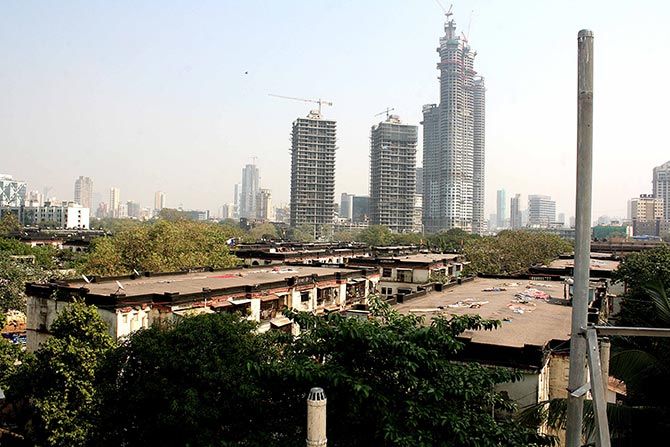Mumbai may pace to a frenetic beat, but the metropolis has hidden corners where life moves more leisurely.
Satish Bodas/Rediff.com visits the city's BDD chawls where neighbours live like one big family.
If you want to see what life was like a few decades ago, I'd suggest a visit to Mumbai's 92-year-old Bombay Development Directorate's chawls.
Families manage in tiny rooms and neighbours, unlike what happens in much of Mumbai, are very much a part of each other's lives. The chawls's residents still share their joys, sorrows and festivals with each other.
BDD is a little oasis in the heart of Mumbai -- where a bustling lifestyle and tall skyscrapers pause to watch a slower, more measured Time that exists in a few old stone buildings.
But the residents -- mainly Hindus and Buddhists -- say it is time for change. Their families have expanded and living in such tiny spaces, plagued by leakage problems, is no longer easy.
Many youngsters have moved out; the older generation waits behind, hoping that redevelopment will take place, yet not completely ready to let go of a life they are so familiar with.
In my eyes, it is one of the last bastions guarding a simple, old-fashioned way of life.

The structures of the BDD chawls were built between 1922 and 1925.

When space is short, windows provide a convenient area for storage.

Kashinath Anna Kakade, who is 95 years old, has created a special calendar.
If you tell him the date of your birth, he will tell you on which day you were born.
He makes it a point to read the newspaper regularly and enjoys drinking a glass of milk every day.
Mr Kakade has been staying here since 1948 and feels that life today is much more comfortable than it was in his youth.
"Then," he says, "we had to go down to fetch water, but now the BMC (Brihammumbai Municipal Corporation) water comes directly to my house."

This old ladder leads to the terrace. Only one person can use it at a time.
As you can see, the ravages of age have begun to show in this old stone structure.

The families living here rely on gas cylinders and kerosene stoves to cook their daily meals.
As you can see, water continues to be a major issue. Look at all the vessels used to store the precious liquid.
Each room is home a family and is self-contained; it includes the bathroom and the kitchen.
The toilets, of course, are communal and are located outside the house.
Each floor houses 20 families in 20 rooms.
There are six toilets on each floor -- three for men and three for women.

This family on the ground floor, like many others in the chawl, uses the extra space outside their house to wash and dry their clothes.
If you look at the photograph carefully, you will see the little door (behind the lady in maroon) they have made under the window for a quick entry and exit.

Sadly, the rear areas of the BDD buildings are used as chicken coops-cum-garbage dumps.

Facing the chawls is a huge open area where children skip out to play... a rarity in Mumbai.

Most of the residents, except those who stay in buildings reserved as residential quarters for the police (known locally as Police Line Buildings), have extended their rooms to get extra space.
Take a look at this picture and you'll know what I mean.

You don't need to live in fancy buildings to have a gymnasium on the premises. Here's a look at the gym at BDD chawl.

Skyscrapers, with their alluring promise of a more modern lifestyle, tower nearby.

Every floor is connected through a long passage, with houses on both sides. These passage, as you can see, become an extension of the houses.

Finally, here's a glimpse of how the new replaces the old -- the old wooden staircase of the chawl has been renovated using tiles and marble.










